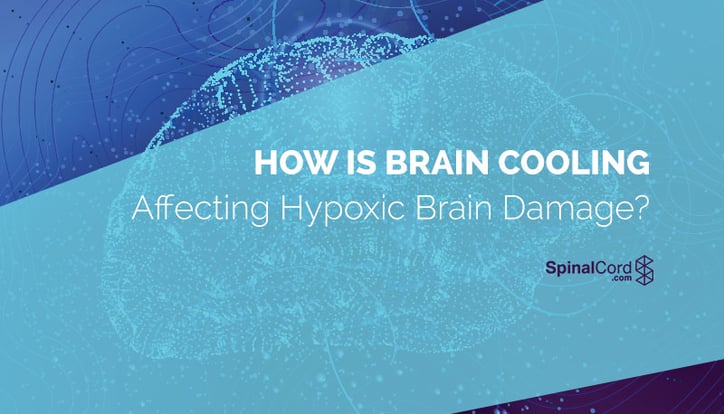How Is Brain Cooling Affecting Hypoxic Brain Damage?
Medical researchers are constantly working to find ways to more effectively treat hypoxia and various forms of brain damage. Many of these treatments can sound unusual, but may prove surprisingly effective at helping survivors of traumatic brain injuries recover. One such unusual-sounding treatment is the use of brain cooling therapy to treat hypoxic brain damage.

What is Hypoxic Brain Damage?
Hypoxic brain damage is a type of injury that occurs as a result of a shortage of oxygen to the brain. Some oxygen is reaching the brain, but not enough for the brain’s needs. This is different from anoxic brain damage, in which the supply of oxygen is completely cut off.
The brain requires a significant amount of oxygen to help it metabolize glucose and power the function of neurons. In fact, although the brain only makes up 2% of your body mass, it uses up to 20% of your regular oxygen supply!
When brain cells don’t get enough oxygen, they begin to die off in as little as a minute. After five minutes, there is risk of brain death and lasting brain damage, even if the oxygen supply is restored.
There are many situations that can cause a loss of oxygen to the brain, such as:
- Strangulation, which blocks blood flow to the brain
- Cardiac arrest
- Choking
- Drowning
- Smoke or carbon monoxide inhalation, which interferes with respiration
Basically, any situation that keeps oxygen-enriched blood from reaching the brain can cause brain hypoxia-related damage.
The long-term effects of hypoxic brain damage are similar to other forms of brain damage, and may include:
- Reduced cognitive function
- Memory loss
- Changes in motor skills
- Chronic pain
- Seizures
- Dementia-like symptoms (confusion, signs of rapid brain aging, etc.)
What is Brain Cooling?
Brain cooling, or therapeutic hypothermia, is a process in which the subject’s body temperature is reduced to a value lower than the norm. In clinical trials in the U.K., the process was used on newborns who suffered from hypoxic ischemic brain injuries following oxygen deprivation at birth.
As noted in an Oxford University news article, the babies “were randomly assigned into two groups within six hours of delivery, and either treated with standard care or standard care plus hypothermia when their body temperature was reduced to 33.5˚C for 72 hours. After that time, they were slowly returned to a normal body temperature of 37˚C.”
In temperature measurements more familiar to most in the U.S., that’s 92.3 and 98.6 degrees Fahrenheit.
How Does Brain Cooling Affect Hypoxic Brain Damage?
By chilling the brain, metabolic processes can be slowed, which can reduce the amount of oxygen the brain needs and slow the processes that cause brain damage.
While this procedure sounds unusual, it seems to have a significantly positive effect based on the results of clinical trials held so far. As noted in a National Institute for Health and Clinical Excellence (NICE) publication about using cooling therapy on infants with brain injuries caused by oxygen deprivation:
“[NICE] looked at all the results from 10 separate studies with a total of 1320 babies. Across the 10 studies, the risk of death was lower in the babies who had cooling compared with babies who were treated by standard care. In 3 of the 10 studies (a total of 767 babies) the combined risk of death or severe disability was lower in babies who had cooling compared with those who did not, and babies who were cooled were more likely to have survived without brain damage after 18 months. In the babies who survived, the risks of severe disability or cerebral palsy were higher in infants treated with standard care compared to those who were treated with cooling.”
The hypothesis for therapeutic hypothermia seems to pan out so far based on trial results—cooling the brain can help prevent or limit the damage caused by oxygen deprivation.
What Does This Mean for People with Hypoxic Brain Damage?
The good news is that the trials indicate that brain cooling therapy can be effective for preventing brain damage in those who suffer a major oxygen deprivation event. However, the data from the trials so far is restricted to the use of the treatment on newborns—not adults who have fully-developed brains.
Also, it’s important to note that brain cooling is a preventative measure to be applied soon after the injuring event—the trial data does not show if it can help those who have already suffered brain hypoxia in the past.
Yet, moving forward, this therapeutic treatment has the potential to help future hypoxic brain damage victims limit the side-effects caused by their injuries, which is still great news.
Hopefully, we will have the cure for traumatic brain injuries (TBIs) of all kinds someday. Until then, we should all keep working to raise awareness of TBI, support the injured, and push for new treatments that can improve the quality of life for those living with brain injuries.
Stay Updated on Advancements On Traumatic Brain &
Spinal Cord Injuries
About the Author





